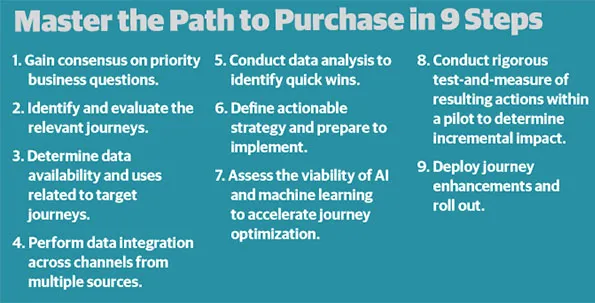The amount of data consumers generate today is mind boggling. It’s estimated that over 2.5 quintillion bytes of data are produced every day, and by 2020 there may be 1.7 MB of data created every second for every person on earth.
If you were to follow all individuals who are browsing your company’s website and examine all their different clicks and views, you would find that everyone is different when it comes to selecting a path to purchase. There is so much going on, it’s easy to miss the important decision points where a data-driven intercession, relevant message, or appropriate offer would pay off in a big way.
Do you have a Data Blind Spot?
All customer data you have available, whether it is offline transactional data or online browsing data, needs to be combined, organized, and properly analyzed and interpreted to inform the next best action during your customer’s shopping process. According to a study by Salesforce, 67 percent of business leaders agree that a connected customer journey across all channels and touchpoints is vital to success. That means understanding who your customers are, what they are doing offline and online, and how that particular search behavior correlates to a sale.
In general, many organizations have their transactional and customer data figured out. They have a general sense of who their customers are, what and when they purchase, and their possible value to the business. The real challenge is to connect that data to customers’ online activity: site visits, clicks, and browsing activity. Many companies have a blind spot when it comes to their digital data. They produce site reports that look at clicks and views, which are typically generated at an aggregated level. To choose the next best action, that data must be collected and integrated at the individual customer level.
There are several reasons why companies don’t leverage all their data to optimize their customers’ paths to purchase:
1. Customer data and digital data are stored in separate data repositories. That separation makes it difficult to connect digital data and customer data in a meaningful way.
2. The sheer amount of digital data needing to be wrangled can be daunting. The upfront effort to get the data to a place where it can be mined and leveraged for valuable insights is significant.
3. For many companies, site traffic is mostly made up of anonymous browsers. Unless they log into the website, companies need to add the extra step of identifying their users by matching cookies to their customer data.
THE RIGHT DATA LEADS TO PERFECT TIMING
We recently conducted an analysis for a client who has millions of online visitors per year, but was experiencing digital blind spots. The company was a very mature client analytically, with a wealth of transactional and customer data that it used effectively to make marketing initiatives more relevant to customers. However, that customer view did not include digital data, such as browsing data, impression data, or online advertising data.
The TTEC team connected several months of online campaign data, cookie, and clickstream data with the client’s customer and transaction data. The team used the Humanify Insights Platform, TTEC’s cloud-based solution, to aggregate the digital and offline customer data into a common architecture and gather a 360-degree view of customer needs, behaviors, and preferences. This drove better insights, and can be leveraged to predict customer churn, lifetime value, and the next best action at the individual customer level.
Once we had all the data, we conducted our analysis. We defined distinct online customer segments, which could be leveraged as a targeting tool for new always-on campaigns. It allowed for more relevant online messaging and more meaningful, variable content when customers visited the client’s website.
We also identified several key decision points during the online shopping process where well-timed offers could make the difference in getting the sale. The client is now taking steps to reach out in more relevant and timely ways during the customer purchase journey.
To be more efficient when delivering online offers, the data can inform personalized offers. The client discovered that discounts such as dollars or percentages off the retail price, do not have to be the same for every customer. Some customers are more promotion-sensitive than others and may need a little extra, while others will buy regardless of the offer presented. By knowing who is browsing, the offer can be tailored to the individual customer.

Paving the Path for AI
If all this sounds familiar, you are either considering investing, or have already invested, in a next best action tool. Many next best action tools out there are marketed to do just that—enhance your customers’ experience on your site by delivering the right content at the right time, based on customer behaviors online (or other channels). The insights generated by analyzing a comprehensive data set can be used to enable next best action’s tools. They inform the business rules and algorithms that drive the decision engines.
Once operationalized, insight can further optimize performance by measuring the results of communication and offer strategies. This entire process will get better with time because all insights are used to improve the effectiveness of the programs and tools. The outcomes are a better shopping experience for customers and a higher business ROI.
Conclusion: Understand every click
The road to understanding your customer’s path to purchase has never mattered more. With an ocean of data out there, organizations need to understand today their customers’ need for relevant information and offers at every point of their journey—whether it be online or offline.
Behind every click, a customer is making a decision about your brand. If you can preemptively identify these key decision points through analysis, you can meet each customer differently. Close the blind spots, add digital data into your path to purchase analysis, and find those key decision points to create impactful ways to close the deal.















